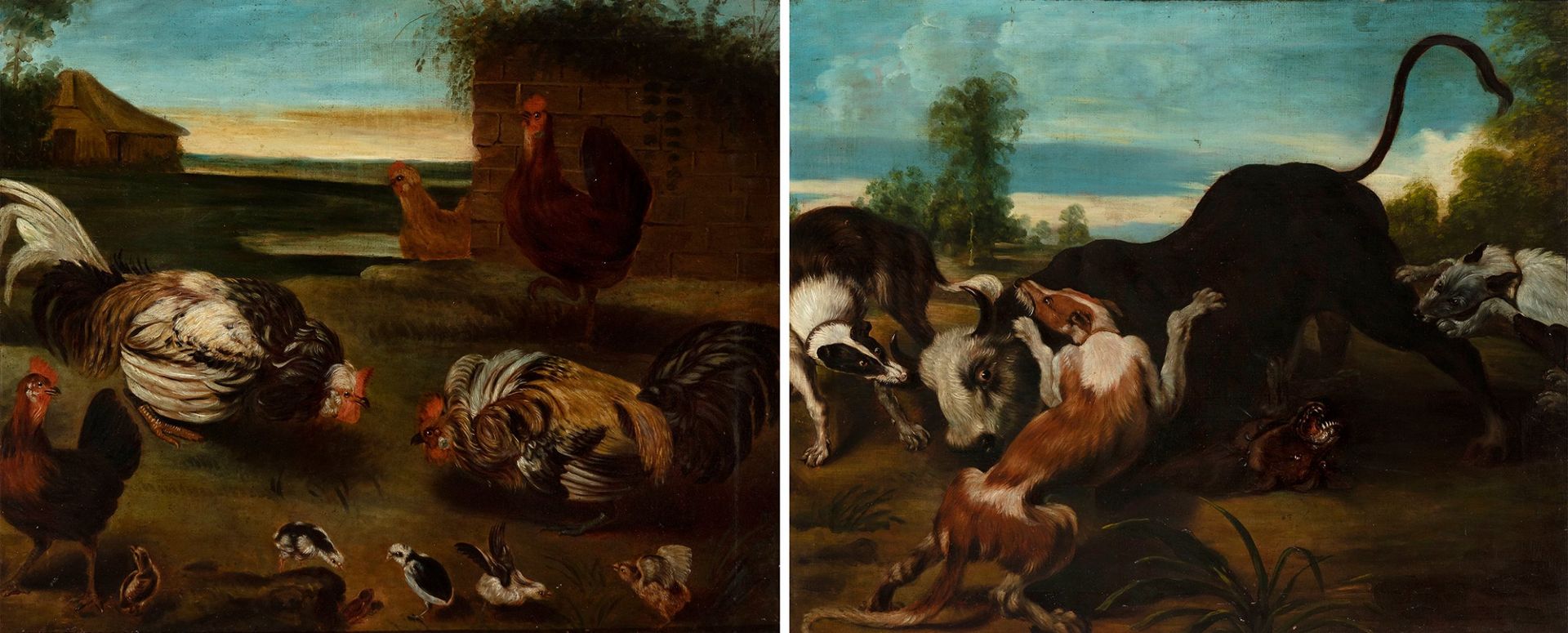Description
Flemish school, 18th century. "Farmyard scene" and "Dogs and bull". Pair of oil paintings on canvas. Restorations. Measurements: 87 x 106 cm; 102 x 120 cm. One of the genres in which the Flemish painting, during the Flemish period, was the animalistic one, which was developed in farmyard and hunting scenes as well as in still lifes. The two paintings here depict farmyard birds and a hunt, respectively. Among the farmyard birds are two roosters whose attitude warns us that they are about to engage in a fight. The whole composition revolves around this expectant feeling. Each animal has been depicted in all its qualities and textures, with its shimmering plumage and lively eyes... The painter shows attentive observation not only of the anatomy, but also of the attitudes and characters: the caution of the hen, the petulance of the cockerel... The other painting is imbued with great expressive power in the confrontation between the bull and the hunting dogs, their bodies convulsed with aggression. During the 17th century in Flanders there was an increasing demand for paintings to decorate the houses of the bourgeoisie. Apart from portraits and large canvases with religious, historical or mythological themes, artists specialised in still lifes, animals, landscapes and genre scenes. Paintings reproducing collectors' cabinets of the period are explicit in this respect, to the point of giving rise to a new, autonomous genre of painting. Undoubtedly, the future of Flemish painting would have been different without Rubens, whose art revolutionised the Flemish art scene by introducing a new, fully Baroque approach and bringing a sense of unity and opulent sumptuousness to the ordered and encyclopaedic collection of his countrymen's precious depictions. Within 17th-century Flemish still-life painting two trends can be distinguished, the static, represented by Clara Peeters and Osias Beert, and the dynamic, with Frans Snyders and Paul de Vos. This work belongs to the second of these schools, which is characterised by following the Rubensian Baroque in a purely dynamic sense. Dynamic still lifes are characterised by compositions with pronounced diagonals, as seen here, and by the frequent presence of live animals interacting with the objects in the still life, captured in full movement.
64
Flemish school, 18th century. "Farmyard scene" and "Dogs and bull". Pair of oil paintings on canvas. Restorations. Measurements: 87 x 106 cm; 102 x 120 cm. One of the genres in which the Flemish painting, during the Flemish period, was the animalistic one, which was developed in farmyard and hunting scenes as well as in still lifes. The two paintings here depict farmyard birds and a hunt, respectively. Among the farmyard birds are two roosters whose attitude warns us that they are about to engage in a fight. The whole composition revolves around this expectant feeling. Each animal has been depicted in all its qualities and textures, with its shimmering plumage and lively eyes... The painter shows attentive observation not only of the anatomy, but also of the attitudes and characters: the caution of the hen, the petulance of the cockerel... The other painting is imbued with great expressive power in the confrontation between the bull and the hunting dogs, their bodies convulsed with aggression. During the 17th century in Flanders there was an increasing demand for paintings to decorate the houses of the bourgeoisie. Apart from portraits and large canvases with religious, historical or mythological themes, artists specialised in still lifes, animals, landscapes and genre scenes. Paintings reproducing collectors' cabinets of the period are explicit in this respect, to the point of giving rise to a new, autonomous genre of painting. Undoubtedly, the future of Flemish painting would have been different without Rubens, whose art revolutionised the Flemish art scene by introducing a new, fully Baroque approach and bringing a sense of unity and opulent sumptuousness to the ordered and encyclopaedic collection of his countrymen's precious depictions. Within 17th-century Flemish still-life painting two trends can be distinguished, the static, represented by Clara Peeters and Osias Beert, and the dynamic, with Frans Snyders and Paul de Vos. This work belongs to the second of these schools, which is characterised by following the Rubensian Baroque in a purely dynamic sense. Dynamic still lifes are characterised by compositions with pronounced diagonals, as seen here, and by the frequent presence of live animals interacting with the objects in the still life, captured in full movement.
